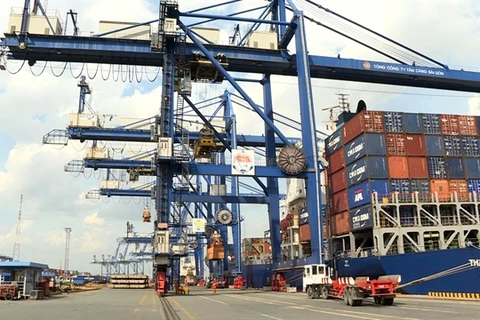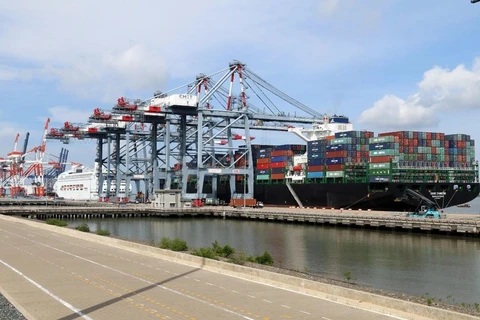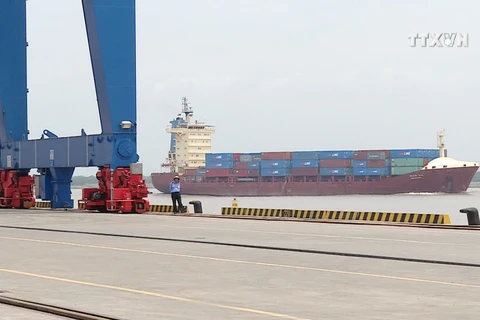HCM City (VNS/VNA) – Ho Chi Minh City is making efforts to improve its logistic services to create a driving force for its economy as well as that of the southern key economic region.
With its strategic location, the city is an important trade gateway for the country’s southern region, accounting for 85.2 billion USD worth of imports and exports last year, or 17.7 percent of the country’s total.
Nguyen Quynh Trang, Deputy Director of the city Department of Industry and Trade, said the city had relatively developed logistics services and played a leading role in cargo transport for the south and the country as a whole.
It transhipped nearly 75 percent of the southern key economic region’s goods and more than 20 percent of the country’s, she said.
According to the Vietnam Logistics Business Association, more than 70 percent of the country’s 3,000 logistics firms are in the city, mainly operating in shipping and delivering, transportation, warehousing, ports, loading and unloading, distribution, customs clearance and integrated logistics services.
The city has more than 40 berths with a total length of 14 km and 61 piers. Last year the volume of cargo passing through its ports increased by 9 percent and this year it is forecast to exceed the capacity targeted next year.
But logistics development faces obstacles like overburdened roads and ports and lack of connectivity.
Le Duy Hiep, the association’s chairman, said high logistics costs, inappropriate policies, tortuous administrative procedures and lack of qualified human resources, experience in supply chain management and facilities were obstacles the city as well as the country in general should resolve soon.
Therefore, the city needed to focus on making zoning plans for logistics infrastructure and invest more on developing its transport system, especially inland waterway transport, and have a strategy to develop human resources for the logistics industry, he said.
Recognising the importance of the logistics industry, the city government has tasked the Department of Industry and Trade to develop a plan or it for until 2025.
The plan aims to develop logistics into a key service sector, develop the city into a regional transshipment port and reduce logistics costs.
Three logistics centres will be developed to better facilitate cargo transportation between the city and other localities, one each in the south and north and one for aviation.
The former two are expected to be at least 40 hectares in size in 2020 and expanded to 70ha by 2030, and linked with ports and inland container depots in the city and Ba Ria-Vung Tau, railway stations and industrial zones.
The aviation logistics centre at Tan Son Nhat International Airport is expected to be at least 3-4 ha in the first phase and 7-8ha in the second.
They will perform two roles: store, tranship and supply goods to the city distribution systems and tranship goods to other cities and provinces and import and export goods through the city’s ports.
With its strategic location, the city is an important trade gateway for the country’s southern region, accounting for 85.2 billion USD worth of imports and exports last year, or 17.7 percent of the country’s total.
Nguyen Quynh Trang, Deputy Director of the city Department of Industry and Trade, said the city had relatively developed logistics services and played a leading role in cargo transport for the south and the country as a whole.
It transhipped nearly 75 percent of the southern key economic region’s goods and more than 20 percent of the country’s, she said.
According to the Vietnam Logistics Business Association, more than 70 percent of the country’s 3,000 logistics firms are in the city, mainly operating in shipping and delivering, transportation, warehousing, ports, loading and unloading, distribution, customs clearance and integrated logistics services.
The city has more than 40 berths with a total length of 14 km and 61 piers. Last year the volume of cargo passing through its ports increased by 9 percent and this year it is forecast to exceed the capacity targeted next year.
But logistics development faces obstacles like overburdened roads and ports and lack of connectivity.
Le Duy Hiep, the association’s chairman, said high logistics costs, inappropriate policies, tortuous administrative procedures and lack of qualified human resources, experience in supply chain management and facilities were obstacles the city as well as the country in general should resolve soon.
Therefore, the city needed to focus on making zoning plans for logistics infrastructure and invest more on developing its transport system, especially inland waterway transport, and have a strategy to develop human resources for the logistics industry, he said.
Recognising the importance of the logistics industry, the city government has tasked the Department of Industry and Trade to develop a plan or it for until 2025.
The plan aims to develop logistics into a key service sector, develop the city into a regional transshipment port and reduce logistics costs.
Three logistics centres will be developed to better facilitate cargo transportation between the city and other localities, one each in the south and north and one for aviation.
The former two are expected to be at least 40 hectares in size in 2020 and expanded to 70ha by 2030, and linked with ports and inland container depots in the city and Ba Ria-Vung Tau, railway stations and industrial zones.
The aviation logistics centre at Tan Son Nhat International Airport is expected to be at least 3-4 ha in the first phase and 7-8ha in the second.
They will perform two roles: store, tranship and supply goods to the city distribution systems and tranship goods to other cities and provinces and import and export goods through the city’s ports.
The city plans to accelerate the construction of key infrastructure projects to boost the logistics industry in the next decade.-VNS/VNA
VNA
























